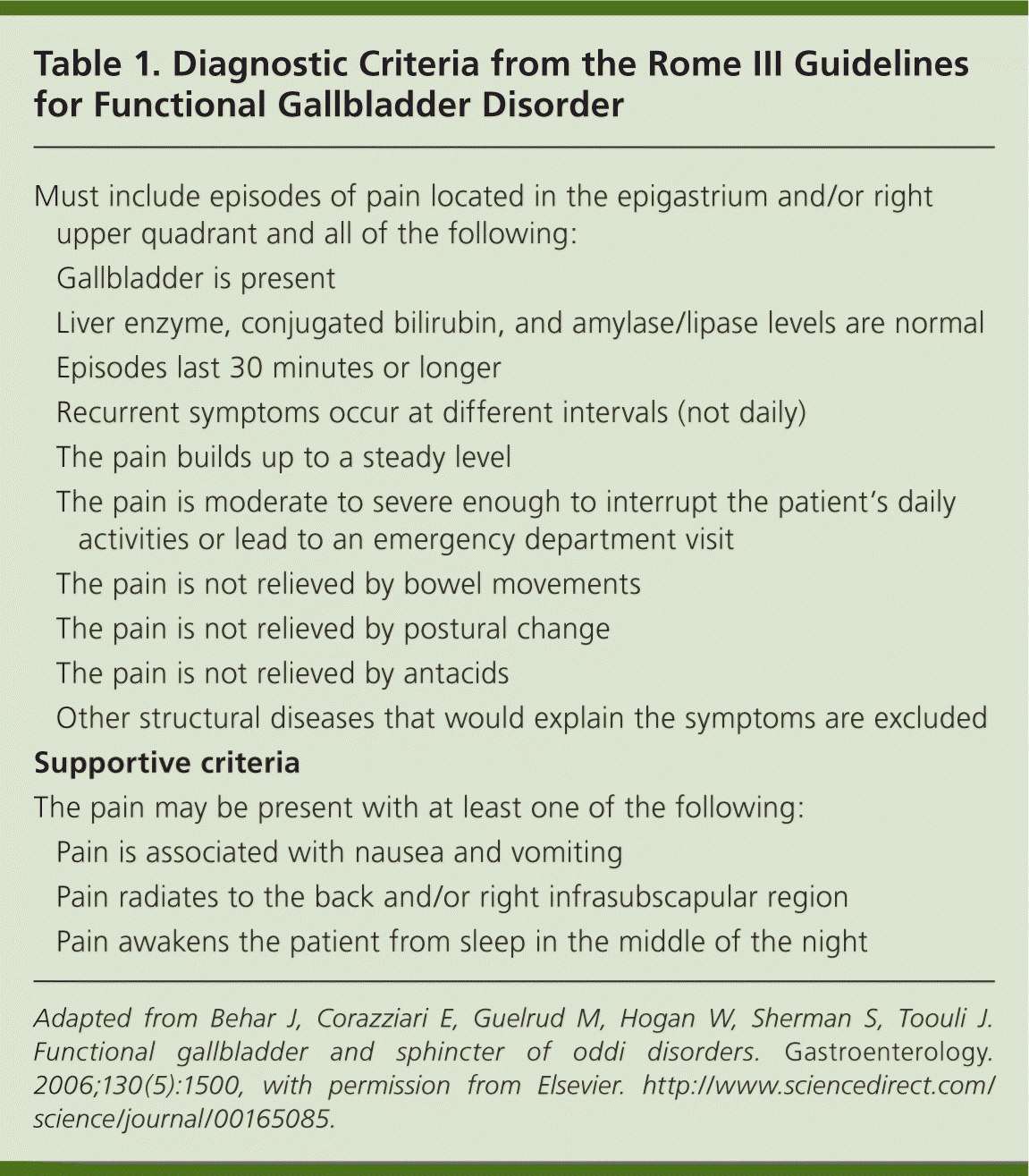
Am Fam Physician. 2014;89(10):779-784
Related article: Surgical and Nonsurgical Management of Gallstones
Author disclosure: No relevant financial affiliations.
Functional gallbladder disorder is a motility disorder of the gallbladder that results in decreased gallbladder contractility and colicky pain. The term is used to cover a constellation of symptoms that have led to their codification in the Rome III criteria (Table 1).1 Previously, functional gallbladder disorder was called chronic acalculous cholecystitis, acalculous cholecystitis, biliary dyskinesia, or biliary dysmotility. It is being diagnosed more often in the office setting, increasing the number of cholecystectomies performed for functional gallbladder disorder over the past two decades from a baseline incidence of 5% to between 20% and 25%.2 Functional gallbladder disorder should be a diagnostic consideration in any patient presenting with classic biliary symptoms and with normal findings on ultrasonography of the right upper quadrant and normal liver and pancreatic enzyme levels.3

| Must include episodes of pain located in the epigastrium and/or right upper quadrant and all of the following: | |
| Gallbladder is present | |
| Liver enzyme, conjugated bilirubin, and amylase/lipase levels are normal | |
| Episodes last 30 minutes or longer | |
| Recurrent symptoms occur at different intervals (not daily) | |
| The pain builds up to a steady level | |
| The pain is moderate to severe enough to interrupt the patient's daily activities or lead to an emergency department visit | |
| The pain is not relieved by bowel movements | |
| The pain is not relieved by postural change | |
| The pain is not relieved by antacids | |
| Other structural diseases that would explain the symptoms are excluded | |
| Supportive criteria | |
| The pain may be present with at least one of the following: | |
| Pain is associated with nausea and vomiting | |
| Pain radiates to the back and/or right infrasubscapular region | |
| Pain awakens the patient from sleep in the middle of the night | |
Etiologically, there seems to be an association between functional gallbladder disorder and obesity. Obesity has been shown in several studies to result in fatty infiltration of the internal organs and to produce a chronic proinflammatory state throughout the body.4–7 Fatty infiltration of the gallbladder and impaired gallbladder contractility secondary to inflammation have also been demonstrated in several studies.4,7–10 These result in poor motility, leading to altered bile composition. The formation of biliary sludge and stones seems to be an end product rather than a cause of biliary symptoms.
Including functional gallbladder disorder in the differential diagnosis of a patient with classic biliary symptoms who has a negative workup is essential. The Rome III criteria can be helpful for guiding the diagnosis and especially for avoiding misdiagnosis. A hepatobiliary iminodiacetic acid (HIDA) scan should be performed in patients meeting Rome III criteria in the presence of normal findings on ultrasonography of the right upper quadrant and normal levels of liver and pancreatic enzymes. A HIDA scan determines how well the gallbladder contracts by measuring the percentage of radioactive dye ejected from the gallbladder over a period of time. An ejection fraction less than 40% is abnormal.
Because not all patients with suspected functional gallbladder disorder will benefit from surgery, clinical considerations and the results of the HIDA scan should be taken into account before proceeding to surgical management. The presence of classic biliary symptoms is of prognostic importance. One study found that patients with classic biliary symptoms were 22 times more likely to have relief after a cholecystectomy than patients who present atypically (P < .0002).11
The Rome III criteria help maximize the chance that surgical outcomes will have long-term clinical benefit. When the criteria are met in the setting of abnormal findings on HIDA scan, cholecystectomy should strongly be considered. The resolution of symptoms after cholecystectomy is near 90% if the Rome III criteria are used for patient selection, with an emphasis on the presenting symptoms.9–13
